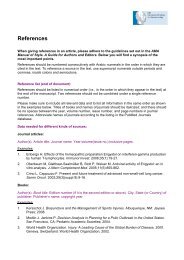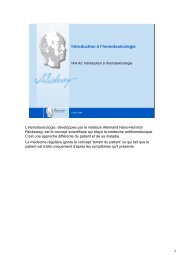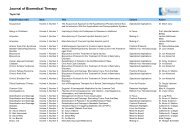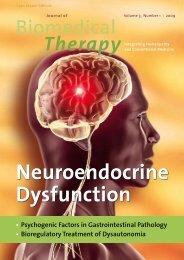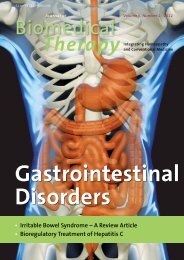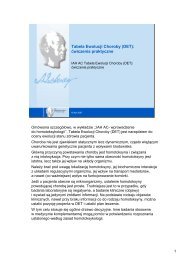Metabolic Syndrome - International Academy of Homotoxicology
Metabolic Syndrome - International Academy of Homotoxicology
Metabolic Syndrome - International Academy of Homotoxicology
Create successful ePaper yourself
Turn your PDF publications into a flip-book with our unique Google optimized e-Paper software.
) Refresh Your <strong>Homotoxicology</strong><br />
Natrium pyruvicum<br />
This is the next product in glucose<br />
metabolism. If the metabolism and<br />
the use <strong>of</strong> this metabolite are not<br />
stimulated, it tends to accumulate in<br />
the cytoplasm, where it is used anaerobically<br />
and induces tissue acidosis.<br />
Citric acid<br />
This is the first stage in the citric<br />
acid cycle and represents a basic<br />
building block not only in the production<br />
<strong>of</strong> energy at this level, but<br />
also in the synthesis <strong>of</strong> essential fatty<br />
acids fundamental to the nerve<br />
structures <strong>of</strong> the organism.<br />
Cis-Aconitic acid<br />
This is a metabolite which forms<br />
very fleetingly. A lack <strong>of</strong> its regulation<br />
leads to general problems <strong>of</strong> tissue<br />
hyperreactivity.<br />
Alpha-Ketoglutaric acid<br />
This is a fundamental stage in the<br />
citric acid cycle, but it is also a fundamental<br />
metabolite in the synthesis<br />
<strong>of</strong> some biological amines important<br />
for the functioning <strong>of</strong> nerve tissue,<br />
such as glutamic acid and glutamine.<br />
If the cycle is blocked at this point,<br />
it causes changes in neuromuscular<br />
function.<br />
Succinic acid<br />
This is the substance used in the innermost<br />
part <strong>of</strong> the mitochondrion<br />
to trigger oxidative phosphorylation,<br />
the peak stage <strong>of</strong> energy production<br />
in the cell. Blocking <strong>of</strong> this<br />
metabolic pathway leads to damage<br />
to tissues, particularly those with a<br />
high energy requirement such as hematopoietic<br />
tissue in particular.<br />
Fumaric acid<br />
This is a key stage not only in the<br />
citric acid cycle but also for a whole<br />
series <strong>of</strong> metabolites involved in the<br />
synthesis <strong>of</strong> fundamental amino acids,<br />
including tyrosine and phenylalanine.<br />
Blockage <strong>of</strong> the cycle at this<br />
point causes disturbances <strong>of</strong> lipid<br />
metabolism.<br />
DL-Malic acid<br />
Blocking <strong>of</strong> the citric acid cycle at<br />
this point prevents the correct use <strong>of</strong><br />
Natrium pyruvicum. Such a blockage<br />
is typical in individuals with senile<br />
diabetes and causes many <strong>of</strong> the<br />
tissue and primary cell problems<br />
that occur in this disease.<br />
Natrium oxalaceticum<br />
This is a key metabolite for triggering<br />
the citric acid cycle through its<br />
reaction with acetyl CoA. A disturbance<br />
<strong>of</strong> this metabolic stage leads<br />
to a general weakening <strong>of</strong> organic<br />
reactivity, making the individual<br />
prone to disease and parenchymal<br />
toxin accumulation. It should also<br />
be noted that Natrium oxalaceticum<br />
is a precursor <strong>of</strong> aspartic acid, which<br />
is involved in the urea cycle and thus<br />
in the production <strong>of</strong> nitric oxide, a<br />
substance which is vital to the circulatory<br />
system.<br />
Barium oxalsuccinicum<br />
This is not a citric acid cycle catalyst<br />
but a salt originally believed by<br />
Reckeweg to activate cell reactivity<br />
in the elderly and in individuals in a<br />
degenerative phase.<br />
In severe or chronic cases, an intensive<br />
stimulation <strong>of</strong> the individual<br />
components <strong>of</strong> the citric acid cycle<br />
catalysts may be beneficial. In my<br />
practice, I use the so-called “Sammelpackung”<br />
(combination pack) <strong>of</strong><br />
the citric acid cycle catalysts to<br />
achieve this.<br />
In this, the 10 ampoules <strong>of</strong> the single<br />
pack <strong>of</strong> catalysts are administered<br />
at the same time, without placing<br />
too much importance on the<br />
route <strong>of</strong> administration. If possible,<br />
the 10 ampoules should be placed<br />
in a small infusion <strong>of</strong> 100 cc, which<br />
should be administered over about<br />
30 minutes. Intramuscular administration<br />
<strong>of</strong> the 10 ampoules is, however,<br />
also effective, and a good effect<br />
can likewise be obtained by the sublingual<br />
route. The administration <strong>of</strong><br />
the 7 citric acid cycle catalysts, the<br />
reactive stimulus salt Barium oxalsuccinicum,<br />
and the trace elements<br />
magnesium, manganese, and phosphorus,<br />
all in a dilute, dynamized<br />
form, gives this mitochondrial metabolic<br />
cycle a remarkable reactive<br />
stimulus.<br />
This “rekindling” or stimulation<br />
should be repeated every 2 to 3<br />
weeks in very elderly patients or<br />
those with metabolic dysfunction or<br />
neo plasia because various toxic<br />
problems other than metabolic problems<br />
tend to re-block the citric acid<br />
cycle. Patients who are not in a<br />
clearly degenerative phase will,<br />
however, need this therapeutic<br />
application only every 3 to 6<br />
months.|<br />
The mitochondrion provides cellular<br />
energy through a series <strong>of</strong> biochemical<br />
reactions called “citric acid cycle.” In<br />
patients with chronic degenerative<br />
diseases, intermediary catalysts are<br />
successfully used to stimulate this<br />
process.<br />
) 17<br />
Journal <strong>of</strong> Biomedical Therapy 2008 ) Vol. 2, No. 1



